Dopo anni di costruzione di siti web WordPress, abbiamo imparato quanto sia importante avere una configurazione locale di WordPress sul proprio computer.
Avere WordPress sul vostro computer personale vi permette di sperimentare nuove funzionalità senza rischiare il vostro sito live, di immergervi in profondità nello sviluppo di WordPress e persino di costruire interi siti web prima che diventino operativi. È come avere una sandbox privata per tutti i vostri progetti WordPress.
Se siete utenti Windows, esistono numerosi modi per configurare WordPress in locale. Ma abbiamo ristretto il campo ai due metodi più semplici. In questa guida vi mostreremo come installare facilmente WordPress su un computer Windows, indipendentemente dalla versione in uso.
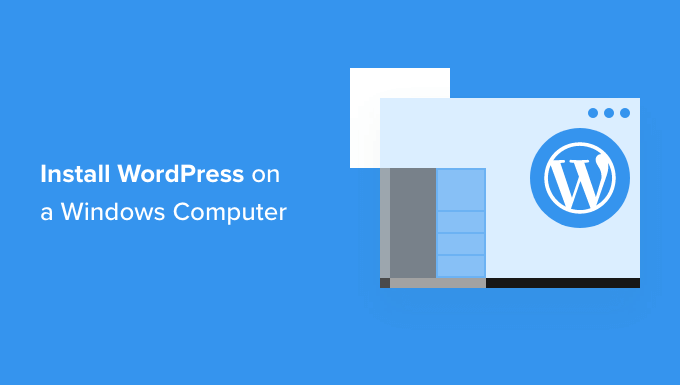
Perché installare WordPress su Windows?
Se siete utenti di Windows, l’installazione di WordPress in locale sul vostro computer offre diversi vantaggi.
Un’installazione locale di WordPress crea un ambiente di prova che non influisce sul vostro sito web reale. Questa configurazione, spesso chiamata server locale o localhost, è il vostro parco giochi personale per WordPress.
Gli sviluppatori di WordPress utilizzano regolarmente installazioni locali per il loro lavoro. Ad esempio, possono usarle per sperimentare nuovi plugin o temi o per testare il sito prima di aggiornare l’editor di blocchi Gutenberg.
Ma non è solo per i professionisti. Se siete alle prime armi con WordPress, una configurazione locale è perfetta per imparare. Potete esplorare le funzionalità, testare temi e plugin e sperimentare liberamente senza preoccuparvi di rompere un sito live.
È importante notare che quando installate WordPress in locale su Windows, solo voi potete vedere il sito. Se volete creare un sito web pubblico, avrete bisogno di un nome di dominio e di un hosting web.
Ora, tecnicamente, è possibile installare WordPress su Windows utilizzando XAMPP, e abbiamo già scritto un tutorial al riguardo.
Detto questo, abbiamo trovato due metodi ancora più semplici di XAMPP per configurare un ambiente WordPress locale, ideali per i principianti o per gli utenti che hanno bisogno di creare rapidamente un sito locale. Potete fare clic sul link qui sotto per passare al metodo che vi interessa:
Metodo 1: Installare WordPress su Windows utilizzando Studio (semplice e veloce)
Per il primo metodo, utilizzeremo Studio. Si tratta di un software locale per WordPress realizzato da Automattic, la società che gestisce e amministra WordPress.com, che è un costruttore di siti web basato sul software WordPress.
Parleremo prima di questo metodo perché è molto più rapido e semplice da seguire, perfetto per i principianti.
Innanzitutto, è necessario aprire il sito web di Studio by WordPress.com. Quindi, fate clic sul pulsante “Download per Windows”.
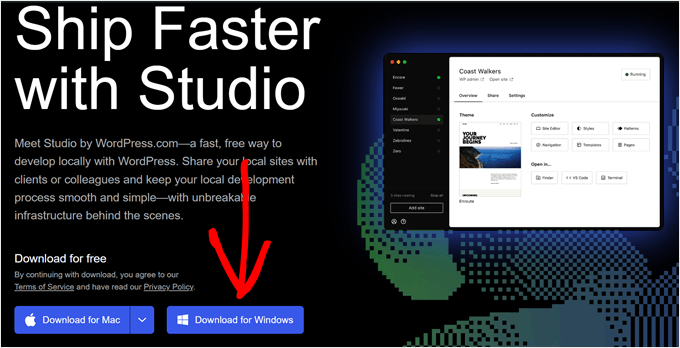
Una volta fatto ciò, basta aprire il file scaricato per avviare l’installazione.
A questo punto apparirà una finestra popup che indica che l’applicazione è in fase di installazione.
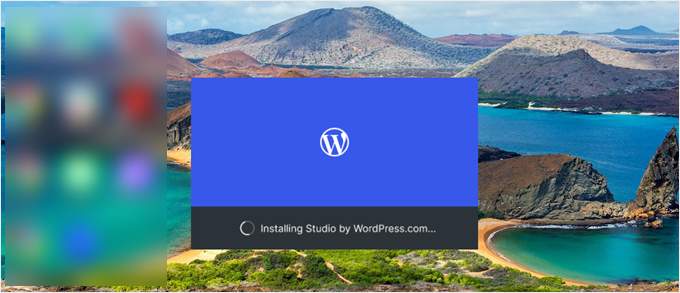
Fatto questo, si può aggiungere il primo sito.
Per farlo, basta inserire il nome del nuovo sito WordPress locale e fare clic su “Aggiungi sito”. Potete dare al sito il nome che preferite, purché vi aiuti a identificarlo facilmente.
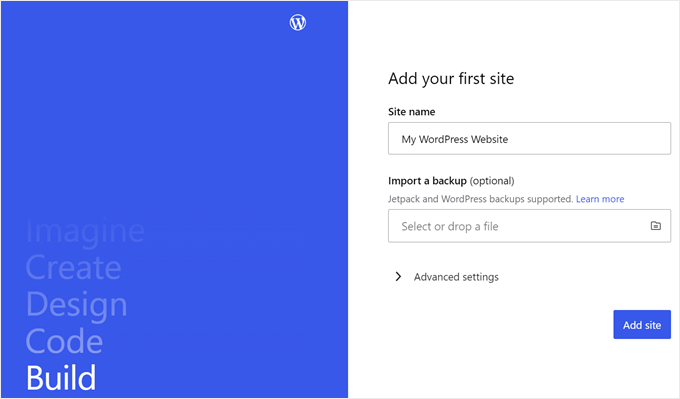
Ora dovreste vedere la dashboard del vostro sito WordPress locale.
Per accedere alla dashboard di WordPress e modificare il sito web, è sufficiente fare clic sul pulsante “Start” nell’angolo in alto a destra. In questo modo il vostro sito web locale sarà accessibile sul vostro computer.
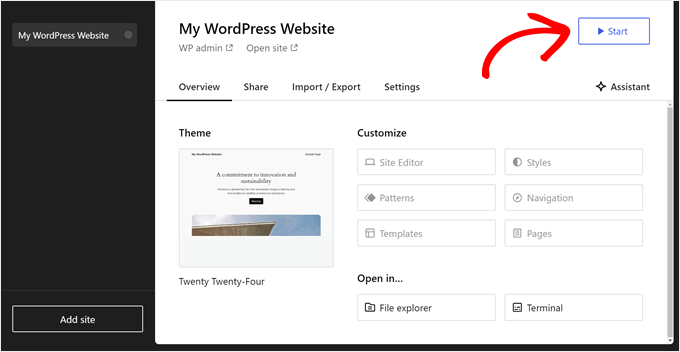
Una volta modificato il pulsante “Avvio” in “In esecuzione”, si può fare clic sul link “WP Admin” in alto a sinistra della pagina.
In questo modo si accede alla pagina di amministrazione locale di WordPress.
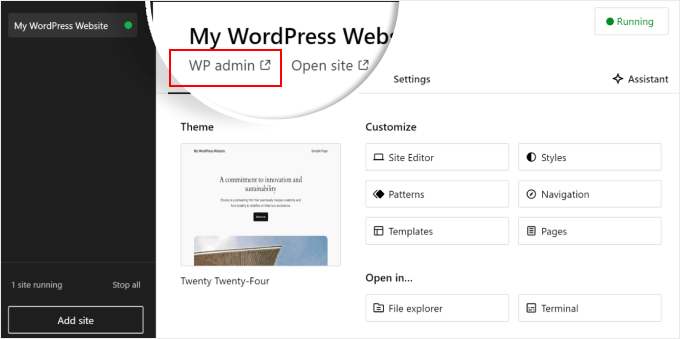
E questo è praticamente tutto per la configurazione. Esaminiamo le altre impostazioni che possono essere necessarie per la creazione del vostro sito web locale.
Come si può vedere nella scheda “Panoramica”, è possibile accedere immediatamente al menu dell’editor completo di WordPress direttamente dalla dashboard di Studio. Potete anche fare clic su “Esplora file” per aprire le cartelle e i file del vostro sito WordPress e fare clic su “Terminale” per gestire il vostro sito web utilizzando WP-CLI.
Se passate alla scheda “Condividi”, potete accedere al vostro account WordPress.com, clonare il vostro sito web locale e caricarlo sui server di WordPress.com. In questo modo il sito clonato sarà temporaneamente online, il che è utile per condividere siti demo con i vostri clienti o membri del team.
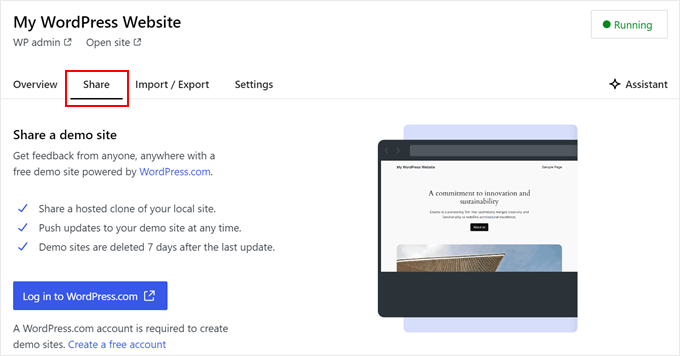
A volte si può desiderare di accedere al proprio sito web locale direttamente tramite il browser, invece di utilizzare Studio. In questo caso, è necessario conoscere le credenziali di wp-admin.
Per trovarli, potete passare alla scheda “Impostazioni” e trovare il nome utente, la password e l’URL di accesso dell’amministratore di WordPress.
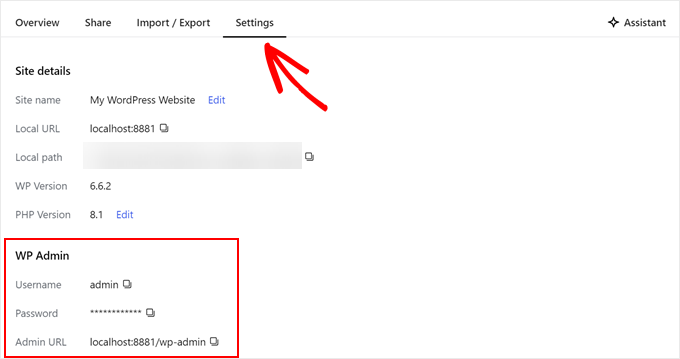
Un’altra caratteristica interessante di Studio è il chatbot AI integrato, con il quale è possibile comunicare facendo clic sul pulsante “Assistente”.
Qui è possibile chiedere aiuto a Studio per compiti come l’aggiornamento di tutti i plugin in una sola volta, l’aggiornamento della versione principale di WordPress o la creazione di codice per un blocco personalizzato.
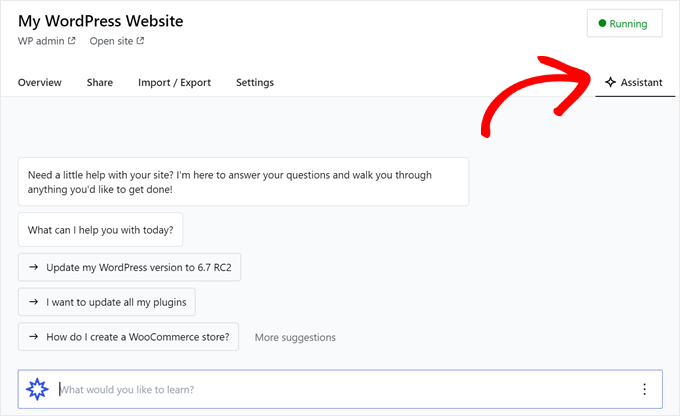
Quando avete finito di lavorare sul vostro sito locale, passate sopra il pulsante “In esecuzione” nell’angolo in alto a destra fino a quando non appare la scritta “Stop”.
Quindi, fare clic sul pulsante per interrompere il sito web.
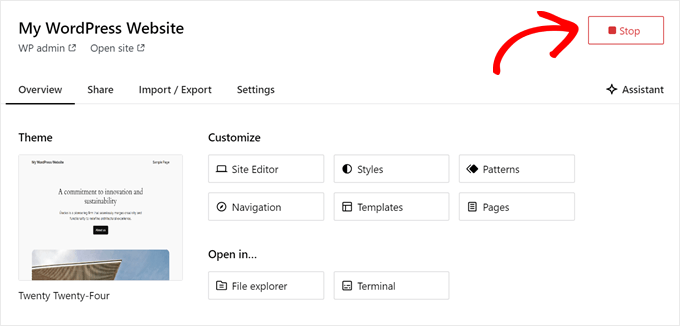
Un aspetto negativo di Studio è che non è possibile configurare l’ambiente WordPress a proprio piacimento. Ciò significa che dovete utilizzare la versione di PHP, il server web e il database che sono stati preselezionati per voi.
Questo può essere uno svantaggio se avete bisogno di testare il vostro sito web o plugin con configurazioni specifiche del server.
Se avete bisogno di un maggiore controllo sull’ambiente WordPress locale o di far coincidere la vostra configurazione locale con una specifica configurazione del server live, potete verificare il metodo successivo che prevede l’uso di WP locale.
Metodo 2: Installare WordPress su Windows utilizzando WP locale (più personalizzabile)
Innanzitutto, è necessario scaricare e installare il software Local WP sul proprio computer Windows. Basta andare sul sito web di Local WP e fare clic sul pulsante “Download for Free”.
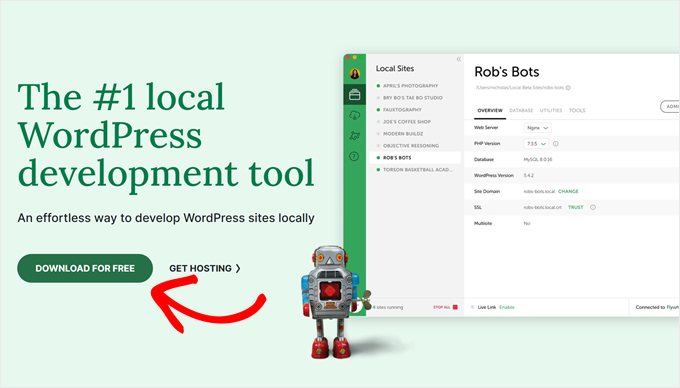
Successivamente, apparirà una finestra popup in cui dovrete selezionare la vostra piattaforma. Scegliete “Windows” dal menu a discesa.
Successivamente, è possibile inserire i propri dati, come nome e cognome, indirizzo e-mail di lavoro e numero di telefono, per scaricare il software.
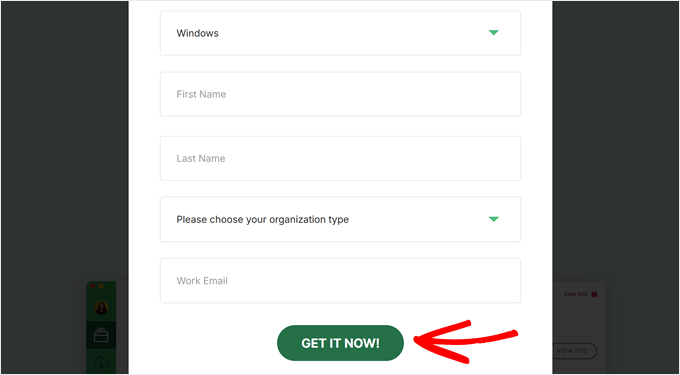
Dopo aver inserito i dati, è sufficiente fare clic sul pulsante “Ottieni ora”.
Successivamente, il software verrà scaricato automaticamente nel computer. Altrimenti, è possibile fare clic sul link “clicca qui” per avviare il download.
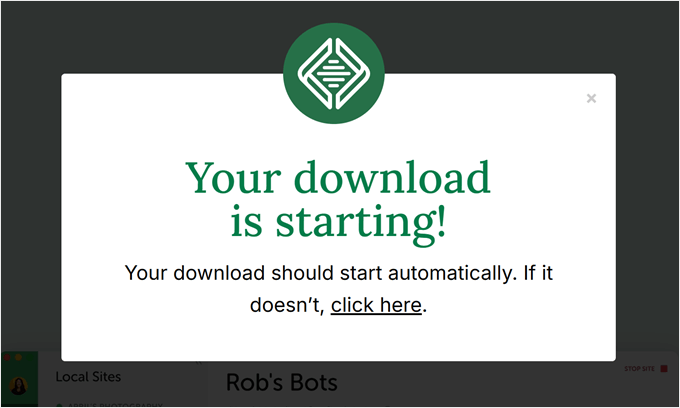
Una volta scaricato il file, avviate la procedura guidata di installazione.
A questo punto, dovrete selezionare se volete installare il software per tutti gli utenti o solo per voi.
Una volta selezionata un’opzione, fare clic sul pulsante “Avanti”.
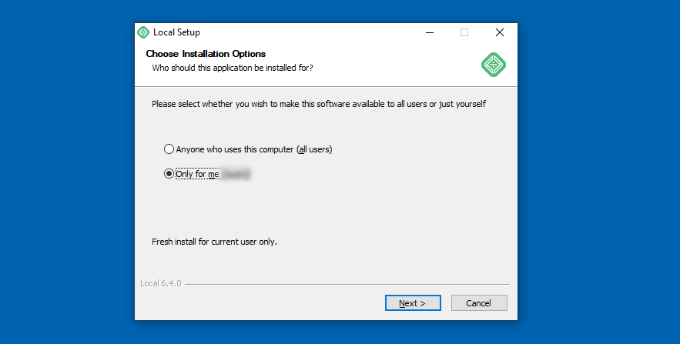
Nel passaggio successivo, è possibile selezionare la “cartella di destinazione” in cui verrà installato il software.
È sufficiente fare clic sul pulsante “Sfoglia” per impostare il percorso e quindi fare clic sul pulsante “Installa”.
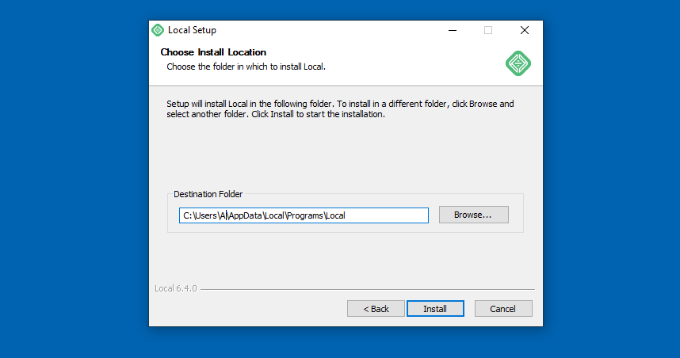
Il software Local WP viene ora installato sul computer Windows.
Una volta terminato, è possibile selezionare la casella di controllo “Esegui in locale” e fare clic sul pulsante “Fine” nella procedura guidata di installazione.
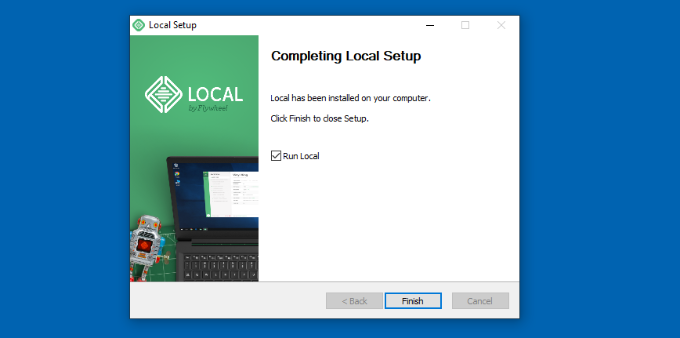
A questo punto il software si avvia sul dispositivo Windows.
Il passo successivo consiste nell’aggiungere un nuovo sito web locale. Per farlo, è sufficiente fare clic sul pulsante “+” in basso.
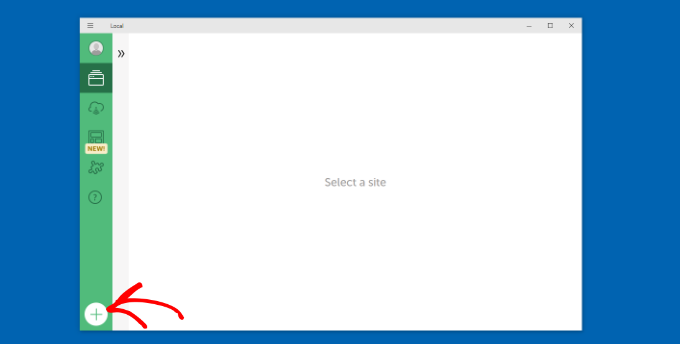
Successivamente, è possibile creare un sito nel software Local.
Selezionare l’opzione “Crea un nuovo sito” e fare clic sul pulsante “Continua”. È possibile creare il sito partendo da un blueprint o da un file di sito esistente, ma a scopo dimostrativo sceglieremo la prima opzione.
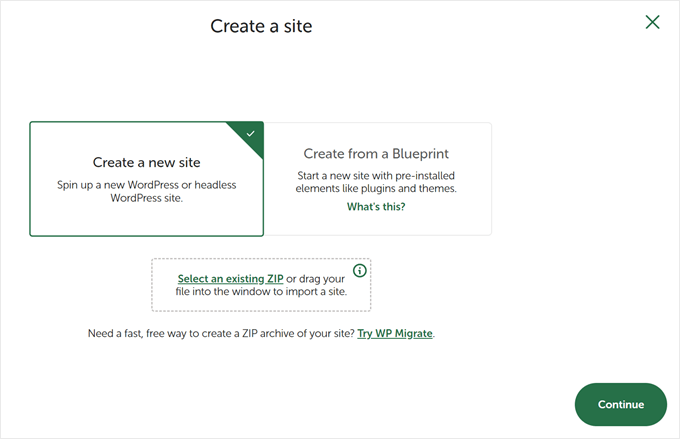
Successivamente, è possibile inserire un nome per il sito web locale, ad esempio “Il mio sito WordPress”.
Sono disponibili anche opzioni avanzate in cui è possibile inserire il dominio del sito locale e il percorso del sito locale. Per impostazione predefinita, il dominio utilizzerà il titolo del sito web, ma separato da trattini.
Una volta terminato, è sufficiente fare clic sul pulsante “Continua”.
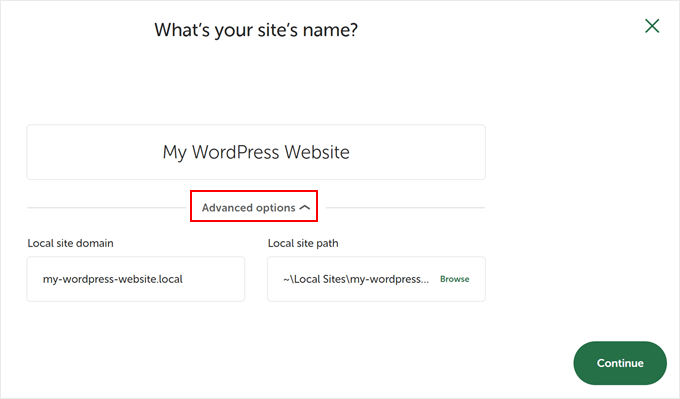
Successivamente, è necessario scegliere un ambiente per il sito web locale.
È possibile utilizzare l’ambiente “Preferito”, in cui il software selezionerà automaticamente la versione di PHP, il server web e la versione di MySQL. D’altra parte, si può anche selezionare “Personalizzato” e inserire i dettagli dell’ambiente.
Local WP offre le ultime versioni di PHP. Per quanto riguarda il server web, è possibile scegliere tra Nginx e Apache. È inoltre possibile scegliere tra MySQL o MariaDB per i database.
Si noti che alcune versioni di PHP, server web e database richiedono il download di alcune dipendenze per funzionare correttamente.
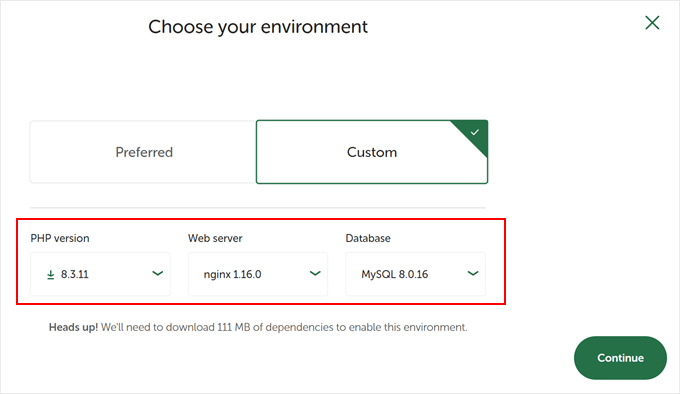
Successivamente, è possibile inserire un nome utente e una password di WordPress per il sito web locale. Inoltre, è possibile scegliere un indirizzo e-mail di WordPress per ricevere tutte le notifiche via e-mail.
Oltre a questo, c’è un’opzione avanzata in cui il software vi chiederà se avete una rete WordPress multisito. In caso contrario, basta fare clic su “No”.
Dopo aver inserito questi dati, è sufficiente fare clic sul pulsante “Aggiungi sito”.
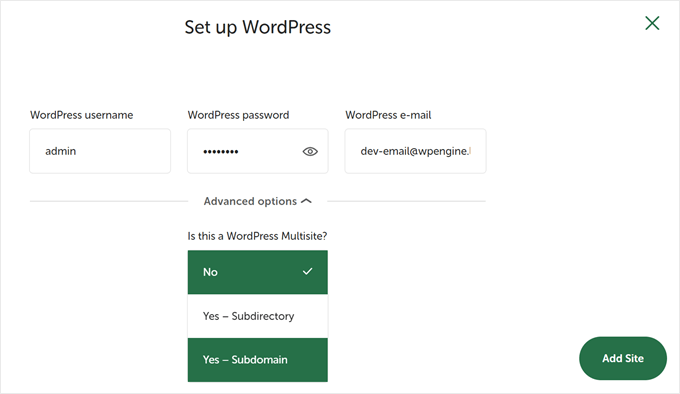
Il software installerà ora WordPress e configurerà il vostro sito web.
Per avviare il sito web locale, fare clic sul pulsante “Avvia sito” nell’angolo in alto a destra.
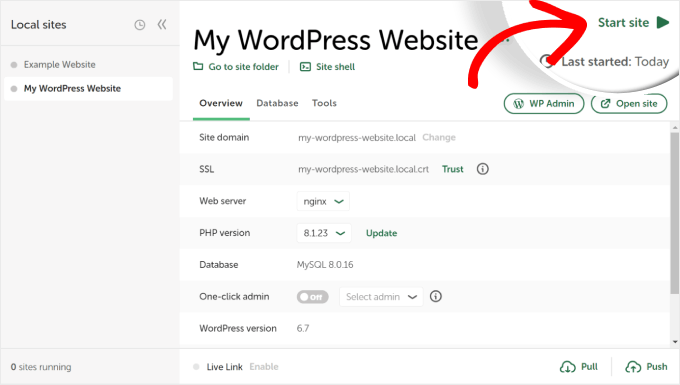
Quindi, fate clic sul pulsante “WP Admin” e vedrete la pagina di accesso all’amministrazione di WordPress.
È sufficiente inserire il nome utente e la password immessi in precedenza durante la configurazione del sito web locale, quindi fare clic sul pulsante “Accedi”.
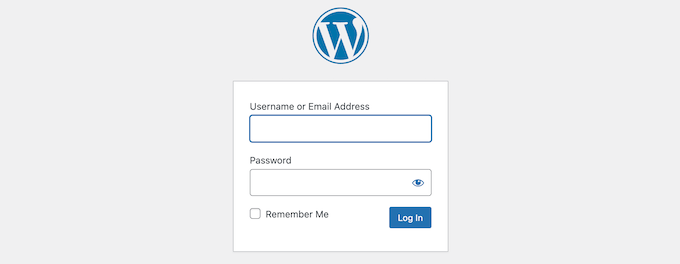
Ora è possibile modificare il sito web locale sul computer Windows.
Una volta terminato, non dimenticate di fermare il sito web dal software Local WP facendo clic sul pulsante “Stop site”.
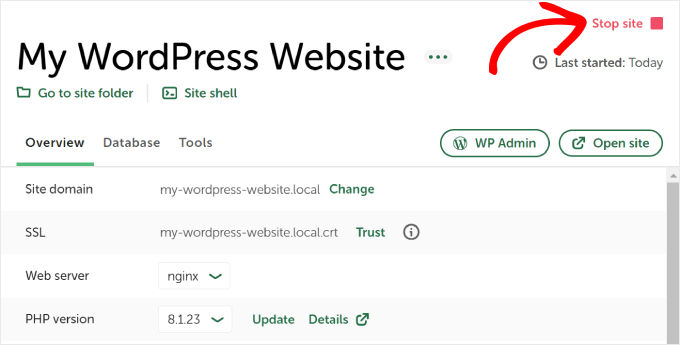
Suggerimento: se si desidera saltare il processo di login, è possibile abilitare il login dell’amministratore con un solo clic in Local WP.
Per farlo, basta tornare alla dashboard di WP locale e attivare il pulsante “Amministratore con un solo clic” fino a quando non appare la dicitura “On”. Quindi, nel menu a discesa, selezionare l’utente amministratore che può utilizzare questa funzione di accesso con un solo clic.
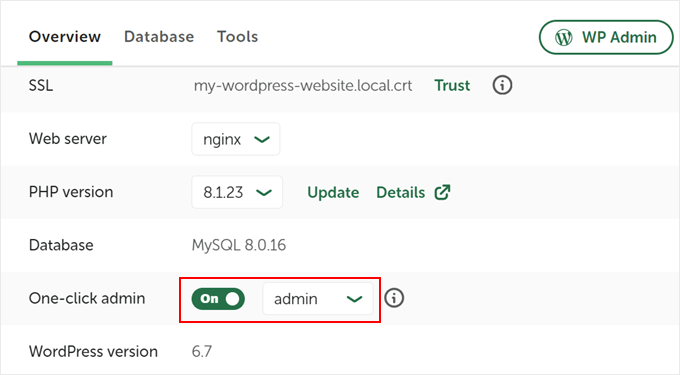
Alternativa: Usare WordPress Playground per testare temi, plugin e altro ancora
WordPress Playground è uno strumento innovativo che consente di sperimentare WordPress direttamente nel browser web. Si tratta di una sandbox virtuale in cui è possibile provare nuovi temi, plugin e funzionalità di WordPress senza influire su alcun sito web reale.
WordPress Playground si differenzia da un ambiente WordPress locale per diversi aspetti fondamentali.
Innanzitutto, non richiede l’installazione sul computer e si ripristina dopo ogni utilizzo, a differenza delle installazioni locali permanenti. È possibile accedervi da qualsiasi dispositivo dotato di browser, mentre le installazioni locali sono legate a un solo computer.
Mentre WordPress Playground è ideale per test e apprendimento rapidi, un ambiente WordPress locale sul vostro computer Windows offre maggiore flessibilità per progetti di sviluppo a lungo termine.
Per una guida dettagliata, consultate la nostra guida su come utilizzare WordPress Playground nel browser.
Ho installato WordPress sul mio computer Windows, e ora?
Ora che avete WordPress sul vostro computer, ecco alcune cose che potete fare:
- Imparate i suggerimenti e i trucchi di base di WordPress per utilizzare meglio il vostro sito.
- Provate diversi temi di WordPress per vedere come può apparire il vostro sito.
- Installate e testate i plugin WordPress indispensabili per aggiungere nuove funzionalità al vostro sito.
- Imparate a risolvere gli errori più comuni di WordPress da soli.
- Provate diversi page builder drag-and-drop per dare al vostro sito un aspetto gradevole.
- Imparate a reimpostare la password di amministrazione di WordPress su localhost per recuperare l’accesso al vostro sito.
- Impostate flussi di lavoro automatizzati per semplificare la gestione del sito.
- Imparate a conoscere la sicurezza di WordPress per mantenere il vostro sito al sicuro dagli hacker.
- Spostate il vostro sito WordPress locale su un server live quando siete pronti a condividerlo con tutti.
Speriamo che questo articolo vi abbia aiutato a capire come installare WordPress in locale su un computer Windows. Potreste anche consultare il nostro articolo su come installare WordPress in locale su un computer Mac e la nostra guida definitiva alla creazione di un sito di staging per WordPress.
Se questo articolo vi è piaciuto, iscrivetevi al nostro canale YouTube per le esercitazioni video su WordPress. Potete trovarci anche su Twitter e Facebook.





mike
installed wamp Apache/2.4.9 (Win32) PHP/5.5.12, downloaded wordpress, configured wp-config nothing, absolutely nothing happens.
Any thoughts?
Villi
Hey. So everything worked great and i have been playing around practicing. Now i am going to make another website but keep the practice website also, but i need them to be completely independent from each other since i dont want my “messing around” to affect the new one Should i install wordpress again and follow the same instructions (extract the wordpress folder to C:\wamp\www etc.) and make another database ?
Should i install wordpress again and follow the same instructions (extract the wordpress folder to C:\wamp\www etc.) and make another database ?
In short, should i follow exactly the same process as before, except i would not need to download wamp again obviously.
Thank you
WPBeginner Support
Yes, you need to follow the same instructions.
Admin
Wayne
Great article. I have managed to get everything up and running. But have not got stuck when I try to upload a Theme I have purchased. I have a personal live site using WordPress. But wanted to build one offline for my workplace, hence I am using phpAdmin. Any ideas please how I can work on purchased themes on a localhost?
WPBeginner Support
Installing a purchased theme is no different on a localhost site than on a live site. Simply go to Appearance > Themes on your localhost site. Click on the Add New button and then click on the Upload button. Click on the choose file button to locate the Theme Zip file from your computer and then upload it.
Admin
Manoj
Hi
I had installed everything as per the guide here and my site was working fine. Today, however, i tried to loginto localhost and it gives an error. It says this webpage is not available. ERR_CONNECTION_REFUSED
Kindly help
naveenraj
hi sir,
The icon says in orange colour and i getting blank pages when i go for localhost/phpmyadmin/ page, Please help t resolve this.
WPBeginner Support
Please see WAMP documentation and support forums.
Admin
bella
“Go to C:\wamp\www and paste wordpress folder there.”
I can’t seem to find anywhere that accepts my wordpress folder. Does anybody have more detailed description to do this step for me? Thank you very much for all you sharing people
Ayesha
Hi,
Once you go to wordpress.org and install wp, you will have a wordpress zip folder, extract its contents and it would create a wordpress folder, open this folder and copy the folder named wordpress. Now goto your wampserver folder and then open www folder that lies insides wampserver folder, paste the folder wordpress over there i.e. inside www folder.
You just have to copy your wordpress folder and paste it in the www folder of wampserver.
Hope that helps!
Kush Singh
Really it’s very helpful site for installing wordpress.
Nice work guys keep it up…
Satish Shihani
Superb….. I really like this
On my first attempt only, i done all installation without any error
Thank you so much for this tutorial
Amir
Smooth and fun, worked like a charm. I had only one problem which was resolved by shutting down a certain Microsoft product…
Thank you.
Paul
Great tutorial glad I found it as I am just learning how to use wamp and my local server to build wordpress sites. I would also like to copy a live wordpress site to my local server so I could modify a theme, then reload it to the remote server and was wondering if there was a tutorial on how to do that? I have found and read the tutorial on uploading a site from my local server to the remote one but nothing on copying a live site to the local server and getting it to work. Is this possible and if so, do you have a tutorial on how to achieve it successfully? Thanks in advance.
Kvaibahv01
Hey there,
I had created a WordPress blog earlier this month and my WAMP server was uninstalled due to some reasons….I reinstalled it>did all the same steps> named the ‘wordpress’ folder to ‘site’> opened localhost/site/wp-admin which says :
Welcome to WordPress. Before getting started,………………………….before proceeding.
Database name
Database username
Database password
Database host
Table prefix (if you want to run more than one WordPress in a single database)
We’re going…………We got it.
In all …………… all ready…
I clicked ‘Let’s go’ button which opened ‘Setup config.File’ entered my DB name ‘site’> ‘username’ and ‘password’ I edited on ‘wp-config-sample.php’ and changed username to blank and same with password too> Click next and now it shows me an error “Can’t select database”:
We ………………. database.
Are you sure it exists?
Does the user have permission to use the site database?
On some systems the name of your database is prefixed with your username, so it would be like username_site. Could that be the problem?
If you don’t know how to set up a database you should contact your host. If all else fails you may find help at the WordPress Support Forums.
Please help!
WPBeginner Support
Visit localhost/phpmyadmin to confirm that the database name you entered is correct.
Admin
Geraldine
Hello. I hope you can help me with this. After I created the test site, how can I share this to my friend via online?
Rhian Williams
thank you so much for this I have been battling with localhost software all day and this worked first time for me
moneytechnicals
Ive installed WAMP in windows 7 32 bit. And want to use wordpress. But its not showing to create configuration file. Its showing an error like this-
Warning:
require(C:wampwwwwordpress-trunk/wp-blog-header.php): failed to open
stream: No such file or directory in
C:wampwwwwordpress-trunkindex.php on line 18
Please help me to get out of this. Thank you in advance.
Campbell Sinclair
Hello and to anyone who googles this error and is stuck like I was on this,
You likely downloaded the zip installer and extracted them, maybe cancelled it some point because the extraction / transfer of the folder inside was slow. I’m not sure what happened, not the point either.
This error occurs when not all the files are present. Try and hunt down wp-blog-header in your WordPress folder directory with a simple search. The index page (one that is first loaded by a browser when it opens a directory) is only asking for this file but it simply won’t be there with it in the directory. Index.php is asking for wp-blog-header and everyone else said I’m not the file you’re looking for.
I downloaded the version prior and it was complete because I had the installation page as expected. This is the quickest and certain fix. If you do this, you will should be able to upgrade to the latest once you have installed as well.
WPBeginner Staff
Yes you can.
ArtaGene
Since I didn’t see any specs listed, not sure my old computer will have enough memory…can I install on a portable drive (connects with USB) and use that way ?
WPBeginner Staff
Seems like WAMP didn’t install correctly on your computer. Try installing again or try XAMP.
jerry
I get this error right at the end of the installation.
httpd.exe – system error
The program can’t start because MSVCR110.dll is missing from your computer. Try reinstalling the program to fix this
problem
nikhil
i have install wamp server but when i am going to phpMyAdmin it is showing error like this:-
Forbidden
You don’t have permission to access /phpmyadmin/ on this server.
Roshan Bagdiya
error
#1045 – Access denied for user ‘root’@’localhost’ (using password: NO)
while accesing phpmyadmin
how to resolve it
WPBeginner Staff
Please make sure that the Wamp server icon in your taskbar turns Green before you click on phpMyAdmin. You can also try manually accessing phpMyAdmin by typing this URL in your browser’s address bar http://localhost/phpmyadmin/
Diviya
Followed your procedure step wise. Now when I try to setup database for WordPress, when I click on phpMyadmin I get error ‘HTTP Error 404. The requested resource is not found’
Syed Balkhi
Done – thanks for the suggestion.
Carrie
FYI, the “Skype” error also happens with a similar program called Team Viewer. A similar simple fix, going in to the program and changing the checkbox regarding ports 80 and 443. I agree with others, if nothing else you should put a link to the troubleshooting info in the article right after the WAMP installation. I got frustrated that I kept getting an error, and decided to look through the comments until I found a solution.
Anand Upadhyay
Suggested edit. Please replace
C:wampwww
with
C:wampwww
Aditya Pranav
Done all thing , but when I click on phpMyadmin the an error page will open in browser and that is :-
HTTP Error 404.0 – Not Found
The resource you are looking for has been removed, had its name changed, or is temporarily unavailable.
Derick
Howe about adding a tutorial that continues from this one on how to add multiple websites to be worked on offline like the above one.
Vijay
Thanks so much for this. It worked for me.
My only complaint is that the skype error should have been right after the WAMP installation part. I spent a lot of time figuring out how to get the WAMP icon to go green instead of orange. Ultimately found out that IIS 8.5 was using port 80 and that I had to stop WWW publishing services from Services.msc and restart the Apache on WAMP to get it to work.
M♥ηyαηє Ramołło™
Great tutorial
Jim
Great tutorial. Big thanks. Only you should post the info on Skype port before in the beginning, as I did everything by myself and changed the port number in wamp folder. Then here I found out that there was easier way doing it on Skype
lobsterhands
Great tutorials. Thank you for being so clear and concise.
Lis
Fab article! I’m all installed and working. However, any additional pages I am creating over and above the home page don’t work. I am creating the page in WordPress, but when following the ‘View’ link, I get a 404. Any idea?
pramod
Downloaded everything. when i write on web http://localhost/mysite/ but display error
The requested URL /mysite/ was not found on this server.
Monica
Very helpful thanks.
St. Buzo of C.O.B. ®
Bingo..!! this was so helpful.!! Phase one done i have installed..!!
anbu
dear sir,
this blog is very usefull to me..as per your instruction i create a website locally. but when i try to open the same site from different machine in tha same lan i can’t.please guide me.
i tried via this following method in another computer
1.http://192.168.1.88/(sitename).
2.http://localhost/(sitename)
the site is not opening
anbu
dear sir,
this blog is very usefull to me..as per your instruction i create a website locally. but when i try to open the same site from different machine in tha same lan i can’t.please guide me.
i tried via this following method in another computer
1.http://192.168.1.88/(sitename).
2.http://localhost/(sitename)
Lyle Denman
http://forum.wampserver.com/read.php?2,121118
This should answer many of your questions. Know that you will also have to update your database’s options (from localhost/phpmyadmin/). wp_options > siteurl and wp_options > home should be changed from http://localhost/database_name to http://your_local_ip_address/database_name (for example http://192.168.0.11/coolsite/).
Make sure you open c:/wamp/bin/apache/apache2.4.9/conf/httpd.conf
In that file, after the line reading: # onlineoffline tag – don’t remove, add the following 2 lines:
Require all granted
Require ip 192.168.0 (or whatever the first 3 groupings of your local ipv4 address is)
Then, in the same file, find the line reading: #Include conf/extra/httpd-vhosts.conf and remove the # from the beginning of that line.
Then, open the file c:/wamp/bin/apache/apache2.4.9/conf/extra/httpd-vhosts.conf and comment out the code that is there (just to keep defaults around) and past the following:
ServerName localhost
DocumentRoot c:/wamp/www
AllowOverride All
Save those files, restart all WAMP services and enjoy your LAN development.
Lina
This post was VERY helpful!! Thank you very much!
WPBeginner Staff
First you need to uninstall wampserver completely from your computer. Then download a fresh copy and try to reinstall. If this does not work out, then we will recommend you to use XAMPP which is an alternate software with nearly the same software (Apache, php, mysql).
Jokerman
I tried EasyPhP too but that didn’t work either. Have just installed Xampp and that appears to be working. Thanks very much for the advice.
Jokerman
I have downloaded and attempted an install. It didn’t work as I was missing a dll file. Have downloaded the necessary software from MS and this time the install appeared to have gone well…no error messages and the Wampserver icon has appeared on my desktop as requested. However when I click on the Wampserver icon it asks: Do you want to the following program from an unknown publisher to make changes to your computer? (Program name: wampmanager.exe) Clicking on Yes causes that window to close then nothing happens. Do you have any clues as to what to try next please? Thank you
cmills
The latest version of wamp uses PHP 5.5.12 which isn’t compatible with WordPress!
WPBeginner Staff
That’r probably because your site is served at 127.0.01 which is a local loop address while the other ip address is your lan address. They are two different things.
To enable sharing you need to add this line to your httpd.conf file Listen 192.168.1.4:80 make sure your computer is using static ip and it is set to use the ip address you enter in apache configuration file.
You will also need to make sure that WordPress saves your IP address as your sites URL not localhost. To achieve this you would need to install wordpress from 192.168.1.4/mysite instead of localhost/mysite
Naresh
Thank you very much.
archetypechris
Hello, and thank you for the amazing guide! I have a small
problem. Everything worked find when I followed the guide and my site loads up
fine, but when I try to connect to it from another computer in my house with
address: 192.168.1.4/mysite, it says I don’t have permission to view the page.
Does anyone know how to fix this? Thank
you!
WPBeginner Staff
You can use the Duplicator plugin or BackupBuddy for site transfers.
Anji
It is my first time creating a website in WP and his post was easy and it worked like a charm! Thank you so much!
WPBeginner Staff
George,
The WordPress you install on your local computer is only available on that computer.
There are specialized software that allow you to install Wampserver on a USB stick which you can then carry with you to work.
George
Thanks for the speedy reply,
Today I installed Wamp on my work laptop and using phpadmin exported my sql database from my home computer and imported it to my work laptop.
I tried mirroring the process above on my work laptop and named the database the same thing. I was able to get into my site on my work laptop but is seems my plugins and theme haven’t transferred. Am I missing a step? Must I transfer another folder?
I was planning on working on a local server doing this transfer sequence between work and home and was wondering if it can even be done (I heard about url linking problems) A short check list or play by play of what I must do would be very helpful.
Thank you,
-George
rustomQ
excellent guide!!!!!! got everything up and running the first time!!! thank you oh so much!!!!
George
This Work wonderfully! I’ve been word pressing for a couple of days and have made some progress over the weekend.
One Problem:
How can I take what I have on my home computer and work on it on my work computer in the office? Can I upload this to wordpress and work on it from anywhere? (I am fine with having a http://www.website.wordpress.com url while I am developing) What are my options to working and showing my development work after following the process above.
I am a complete newbie but willing to learn, a quick tutorial on that process and options would be greatly appreciated. Great work so far and thank you for all the resources you guys provide.
Thomas
*facepalm* There is a link just above to resolve the problem. Sorry about that! Thanks again for this great tutorial!